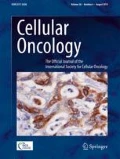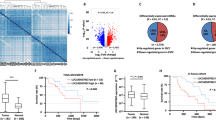Abstract
Background
Long non-coding RNAs (lncRNAs) are known as RNAs that do not encode proteins and that are more than 200 nucleotides in size. Previously, it has been found that LncRNAs play crucial roles in normal cellular processes, including proliferation and apoptosis. A growing body of evidence suggests that lncRNAs may also play regulatory roles in the initiation, progression and metastasis of various malignancies, including breast cancer. SNHG6 is a lncRNA that has previously been found to contribute to the initiation and progression of hepatocellular and gastric carcinomas. In this study, the clinical significance of SNHG6 expression in breast cancer was investigated.
Methods
SNHG6 expression in primary breast cancer tissues was assessed using RT-qPCR. The functional role of SNHG6 was investigated using RNAi-mediated silencing and exogenous overexpression in breast cancer-derived cells. MTT, colony formation, cell cycle, apoptosis and senescence assays were used to determine the impact of SNHG6 expression on breast cancer-derived cells. The effect of SNHG6 on the migration and epithelial-to-mesenchymal transition (EMT) of breast cancer-derived cells was determined using scratch wound healing and immunofluorescence assays, respectively.
Results
We found that the expression of SNHG6 was significantly upregulated in primary high-grade and progesterone receptor (PR)-positive breast tumours. Additional siRNA-based experiments revealed that SNHG6 silencing led to G1 cell cycle arrest in SK-BR-3 and MDA-MB-231 breast cancer-derived cells. Moreover, we found that SNHG6 silencing led to suppressed breast cancer cell proliferation by inducing apoptosis and senescence. Our data also indicate that SNHG6 may contribute to the migration and EMT of breast cancer cells.
Conclusions
Our results indicate that lncRNA SNHG6 is involved in breast cancer development and may be considered as a potential biomarker for the diagnosis, prognosis and treatment of breast cancer.






Similar content being viewed by others
References
R.L. Siegel, K.D. Miller, A. Jemal, Cancer statistics, 2017. CA Cancer J. Clin. 67, 7–30 (2017)
P. Samadi, S. Saki, F.K. Dermani, M. Pourjafar, M. Saidijam, Emerging ways to treat breast cancer: Will promises be met? Cell. Oncol. 41, 605–621 (2018)
V. Tripathi, J.D. Ellis, Z. Shen, D.Y. Song, Q. Pan, A.T. Watt, S.M. Freier, C.F. Bennett, A. Sharma, P.A. Bubulya, The nuclear-retained noncoding RNA MALAT1 regulates alternative splicing by modulating SR splicing factor phosphorylation. Mol. Cell 39, 925–938 (2010)
S.Y. Ng, R. Johnson, L.W. Stanton, Human long non-coding RNAs promote pluripotency and neuronal differentiation by association with chromatin modifiers and transcription factors. EMBO J. 31, 522–533 (2012)
J.E. Wilusz, H. Sunwoo, D.L. Spector, Long noncoding RNAs: Functional surprises from the RNA world. Genes Dev. 23, 1494–1504 (2009)
R. Castro-Oropeza, J. Melendez-Zajgla, V. Maldonado, K. Vazquez-Santillan, The emerging role of lncRNAs in the regulation of cancer stem cells. Cell. Oncol. 41, 585–603 (2018)
S.P. Nana-Sinkam, C.M. Croce, Non-coding RNAs in cancer initiation and progression and as novel biomarkers. Mol. Oncol. 5, 483–491 (2011)
F. Calore, F. Lovat, M. Garofalo, Non-coding RNAs and cancer. Int. J. Mol. Sci. 14, 17085–17110 (2013)
M.L. Pecero, J. Salvador-Bofill, S. Molina-Pinelo, Long non-coding RNAs as monitoring tools and therapeutic targets in breast cancer. Cell. Oncol. 42, 1–12 (2019). https://doi.org/10.1007/s13402-018-0412-6
R.H. Fan, J.N. Guo, W. Yan, M.D. Huang, C.L. Zhu, Y.M. Yin, X.F. Chen, mall nucleolar host gene 6 promotes esophageal squamous cell carcinoma cell proliferation and inhibits cell apoptosis. Oncol. Lett. 15, 6497–6502 (2018)
A.G. Matera, R.M. Terns, M.P. Terns, Non-coding RNAs: Lessons from the small nuclear and small nucleolar RNAs. Nat. Rev. Mol. Cell Biol. 8, 209–220 (2007)
H. Su, T. Xu, S. Ganapathy, M. Shadfan, M. Long, T.H. Huang, I. Thompson, Z. Yuan, Elevated snoRNA biogenesis is essential in breast cancer. Oncogene 33, 1348–1358 (2014)
L. Chang, Y. Yuan, C. Li, T. Guo, H. Qi, Y. Xiao, X. Dong, Z. Liu, Q. Liu, Upregulation of SNHG6 regulates ZEB1 expression by competitively binding miR-101-3p and interacting with UPF1 in hepatocellular carcinoma. Cancer Lett. 383, 183–194 (2016)
C. Cao, T. Zhang, D. Zhang, L. Xie, X. Zou, L. Lei, D. Wu, L. Liu, The long non-coding RNA, SNHG6-003, functions as a competing endogenous RNA to promote the progression of hepatocellular carcinoma. Oncogene 36, 1112–1122 (2017)
K. Yan, J. Tian, W. Shi, H. Xia, Y. Zhu, LncRNA SNHG6 is associated with poor prognosis of gastric Cancer and promotes cell proliferation and EMT through epigenetically silencing p27 and sponging miR-101-3p. Cell. Physiol. Biochem. 42, 999–1012 (2017)
K. Itahana, Y. Itahana, G.P. Dimri, Colorimetric detection of senescence-associated β galactosidase. Methods Mol. Biol. 956, 143–156 (2013)
H.R. Bardaji, M.H. Asadi, M.M. Yaghoobi, Long noncoding RNA VIM-AS1 promotes colorectal cancer progression and metastasis by inducing EMT. Eur. J. Cell Biol. 97, 279–288 (2018)
F.J. Alipoor, M.H. Asadi, M.T. Mahani, MIAT lncRNA is overexpressed in breast cancer and its inhibition triggers senescence and G1 arrest in MCF7 cell line. J. Cell. Biochem. 119, 6470–6481 (2018)
J.R. Prensner, W. Chen, S. Han, M.K. Iyer, Q. Cao, V. Kothari, J.R. Evans, K.E. Knudsen, M.T. Paulsen, M. Ljungman, T.S. Lawrence, A.M. Chinnaiyan, F.Y. Feng, The long non-coding RNA PCAT-1 promotes prostate cancer cell proliferation through cMyc. Neoplasia 16, 900–908 (2014)
T. Du, B. Zhang, S. Zhang, X. Jiang, P. Zheng, J. Li, M. Yan, Z. Zhu, B. Liu, Decreased expression of long non-coding RNA WT1-AS promotes cell proliferation and invasion in gastric cancer. Biochim. Biophys. Acta 1862, 12–19 (2015)
S. Yang, J. Liu, A.D. Thor, X. Yang, Caspase expression profile and functional activity in a panel of breast cancer cell lines. Oncol. Rep. 17, 1229–1235 (2007)
J.P. Alao, The regulation of cyclin D1 degradation: Roles in cancer development and the potential for therapeutic invention. Mol. Cancer 6, 24 (2007)
F. Rodier, J. Campisi, Four faces of cellular senescence. J. Cell Biol. 192, 547–556 (2011)
M. Mumcuoglu, S. Bagislar, H. Yuzugullu, H. Alotaibi, S. Senturk, P. Telkoparan, B. Gur-Dedeoglu, B. Cingoz, B. Bozkurt, U.H. Tazebay, The ability to generate senescent progeny as a mechanism underlying breast cancer cell heterogeneity. PLoS One 5, e11288 (2010)
B.G. Childs, D.J. Baker, J.L. Kirkland, J. Campisi, J.M. Van Deursen, Senescence and apoptosis: Dueling or complementary cell fates? EMBO Rep. 15, 1139–1153 (2014)
B. De Craene, G. Berx, Regulatory networks defining EMT during cancer initiation and progression. Nat. Rev. Cancer 13, 97–110 (2013)
E. Whiteman, C. Liu, E. Fearon, B. Margolis, The transcription factor snail represses Crumbs3 expression and disrupts apico-basal polarity complexes. Oncogene 27, 3875–3879 (2008)
Acknowledgments
This research was supported by the Iran National Science Foundation (INSF) grant number 93030186. All biological materials were provided by the IRAN NATIONAL TUMOR BANK, which is funded by the Cancer Institute of Tehran University of Medical Sciences for Cancer Research.
Author information
Authors and Affiliations
Corresponding author
Ethics declarations
Conflict of interest
The authors declared that they have no conflicts of interest.
Additional information
Publisher’s note
Springer Nature remains neutral with regard to jurisdictional claims in published maps and institutional affiliations.
Rights and permissions
About this article
Cite this article
Jafari-Oliayi, A., Asadi, M.H. SNHG6 is upregulated in primary breast cancers and promotes cell cycle progression in breast cancer-derived cell lines. Cell Oncol. 42, 211–221 (2019). https://doi.org/10.1007/s13402-019-00422-6
Accepted:
Published:
Issue Date:
DOI: https://doi.org/10.1007/s13402-019-00422-6




